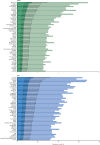Global, regional, and national estimates of the population at increased risk of severe COVID-19 due to underlying health conditions in 2020: a modelling study
- PMID: 32553130
- PMCID: PMC7295519
- DOI: 10.1016/S2214-109X(20)30264-3
Global, regional, and national estimates of the population at increased risk of severe COVID-19 due to underlying health conditions in 2020: a modelling study
Abstract
Background: The risk of severe COVID-19 if an individual becomes infected is known to be higher in older individuals and those with underlying health conditions. Understanding the number of individuals at increased risk of severe COVID-19 and how this varies between countries should inform the design of possible strategies to shield or vaccinate those at highest risk.
Methods: We estimated the number of individuals at increased risk of severe disease (defined as those with at least one condition listed as "at increased risk of severe COVID-19" in current guidelines) by age (5-year age groups), sex, and country for 188 countries using prevalence data from the Global Burden of Diseases, Injuries, and Risk Factors Study (GBD) 2017 and UN population estimates for 2020. The list of underlying conditions relevant to COVID-19 was determined by mapping the conditions listed in GBD 2017 to those listed in guidelines published by WHO and public health agencies in the UK and the USA. We analysed data from two large multimorbidity studies to determine appropriate adjustment factors for clustering and multimorbidity. To help interpretation of the degree of risk among those at increased risk, we also estimated the number of individuals at high risk (defined as those that would require hospital admission if infected) using age-specific infection-hospitalisation ratios for COVID-19 estimated for mainland China and making adjustments to reflect country-specific differences in the prevalence of underlying conditions and frailty. We assumed males were twice at likely as females to be at high risk. We also calculated the number of individuals without an underlying condition that could be considered at increased risk because of their age, using minimum ages from 50 to 70 years. We generated uncertainty intervals (UIs) for our estimates by running low and high scenarios using the lower and upper 95% confidence limits for country population size, disease prevalences, multimorbidity fractions, and infection-hospitalisation ratios, and plausible low and high estimates for the degree of clustering, informed by multimorbidity studies.
Findings: We estimated that 1·7 billion (UI 1·0-2·4) people, comprising 22% (UI 15-28) of the global population, have at least one underlying condition that puts them at increased risk of severe COVID-19 if infected (ranging from <5% of those younger than 20 years to >66% of those aged 70 years or older). We estimated that 349 million (186-787) people (4% [3-9] of the global population) are at high risk of severe COVID-19 and would require hospital admission if infected (ranging from <1% of those younger than 20 years to approximately 20% of those aged 70 years or older). We estimated 6% (3-12) of males to be at high risk compared with 3% (2-7) of females. The share of the population at increased risk was highest in countries with older populations, African countries with high HIV/AIDS prevalence, and small island nations with high diabetes prevalence. Estimates of the number of individuals at increased risk were most sensitive to the prevalence of chronic kidney disease, diabetes, cardiovascular disease, and chronic respiratory disease.
Interpretation: About one in five individuals worldwide could be at increased risk of severe COVID-19, should they become infected, due to underlying health conditions, but this risk varies considerably by age. Our estimates are uncertain, and focus on underlying conditions rather than other risk factors such as ethnicity, socioeconomic deprivation, and obesity, but provide a starting point for considering the number of individuals that might need to be shielded or vaccinated as the global pandemic unfolds.
Funding: UK Department for International Development, Wellcome Trust, Health Data Research UK, Medical Research Council, and National Institute for Health Research.
Copyright © 2020 The Author(s). Published by Elsevier Ltd. This is an Open Access article under the CC BY 4.0 license. Published by Elsevier Ltd.. All rights reserved.
Figures





Comment in
-
COVID-19: rethinking risk.Lancet Glob Health. 2020 Aug;8(8):e974-e975. doi: 10.1016/S2214-109X(20)30276-X. Epub 2020 Jun 15. Lancet Glob Health. 2020. PMID: 32553131 Free PMC article. No abstract available.
-
COVID-19: a new lens for non-communicable diseases.Lancet. 2020 Sep 5;396(10252):649. doi: 10.1016/S0140-6736(20)31856-0. Lancet. 2020. PMID: 32891195 Free PMC article. No abstract available.
-
Work a key determinant in COVID-19 risk.Lancet Glob Health. 2020 Nov;8(11):e1368. doi: 10.1016/S2214-109X(20)30411-3. Epub 2020 Sep 25. Lancet Glob Health. 2020. PMID: 32986980 Free PMC article. No abstract available.
-
Clinical differences between transthyretin cardiac amyloidosis and hypertensive heart disease.Med Clin (Barc). 2024 Mar 8;162(5):205-212. doi: 10.1016/j.medcli.2023.10.006. Epub 2023 Dec 2. Med Clin (Barc). 2024. PMID: 38044190 English, Spanish.
References
-
- Instituto Superiore di Sanità. COVID-19 Surveillance Group Characteristics of COVID-19 patients dying in Italy: report based on available data on March 20th, 2020. 2020. 2020. https://www.epicentro.iss.it/coronavirus/bollettino/Report-COVID-2019_20...
-
- Centre for Evidence-Based Medicine In patients of COVID-19, what are the symptoms and clinical features of mild and moderate cases? April 1, 2020. https://www.cebm.net/covid-19/in-patients-of-covid-19-what-are-the-sympt...
-
- WHO Global Surveillance for human infection with coronavirus disease (COVID-19) March 20, 2020. https://www.who.int/publications-detail/global-surveillance-for-human-in...
Publication types
MeSH terms
Grants and funding
LinkOut - more resources
Full Text Sources
Medical

